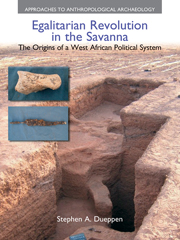Book contents
- Frontmatter
- Dedication
- Contents
- List of Figures
- List of Tables
- Acknowledgments
- 1 Decentralization and the Evolution of Egalitarian Behaviors in Sedentary Societies
- 2 Ancient Villages in the Niger Bend: Context and Methods for Exploring the Voltaic Region
- 3 Ethnographic Perspectives on Western Burkina Faso: A Survey
- 4 Kirikongo: An Introduction to the Site, the Setting, and the Research Design
- 5 The West African Environmental Setting: Kirikongo in Ecological Context
- 6 Stratigraphies and Depositional Episodes: The Excavations
- 7 Relative Chronology: Ceramics
- 8 Community Growth at Kirikongo: The Spatial and Temporal Setting
- 9 Early Sedentary Life in the Voltaic Region: Defining a ‘Voltaic Tradition’
- 10 Craft Production at Kirikongo: The Origins, Development and Reinterpretation of Specialization
- 11 Herding, Farming, and Ritual Sacrifice: The Economy from Kirikongo
- 12 Death and Ritual Objects at Kirikongo: House-Based Social Differentiation
- 13 Archaeological Patterns and Social Process: Reconstructing Changing Life at Kirikongo
- 14 Land, Spiritual Power, and Gerontocracy: An Exploration of the Roots of Egalitarian Revolution in the Western Voltaic Region
- 15 Hierarchy and Egalitarianism within the Niger Bend: Revolution and the Triumph of Communalism
- Bibliography
- Index
7 - Relative Chronology: Ceramics
- Frontmatter
- Dedication
- Contents
- List of Figures
- List of Tables
- Acknowledgments
- 1 Decentralization and the Evolution of Egalitarian Behaviors in Sedentary Societies
- 2 Ancient Villages in the Niger Bend: Context and Methods for Exploring the Voltaic Region
- 3 Ethnographic Perspectives on Western Burkina Faso: A Survey
- 4 Kirikongo: An Introduction to the Site, the Setting, and the Research Design
- 5 The West African Environmental Setting: Kirikongo in Ecological Context
- 6 Stratigraphies and Depositional Episodes: The Excavations
- 7 Relative Chronology: Ceramics
- 8 Community Growth at Kirikongo: The Spatial and Temporal Setting
- 9 Early Sedentary Life in the Voltaic Region: Defining a ‘Voltaic Tradition’
- 10 Craft Production at Kirikongo: The Origins, Development and Reinterpretation of Specialization
- 11 Herding, Farming, and Ritual Sacrifice: The Economy from Kirikongo
- 12 Death and Ritual Objects at Kirikongo: House-Based Social Differentiation
- 13 Archaeological Patterns and Social Process: Reconstructing Changing Life at Kirikongo
- 14 Land, Spiritual Power, and Gerontocracy: An Exploration of the Roots of Egalitarian Revolution in the Western Voltaic Region
- 15 Hierarchy and Egalitarianism within the Niger Bend: Revolution and the Triumph of Communalism
- Bibliography
- Index
Summary
Pottery production, as with any technological act, is a social process that is part of a general social mileau entailing symbolic, economic, political, and religious dimensions (Leroi- Gourhan 1943, 1945; Mauss 1954; Lemmonier 1992). Shared sets of understandings among members of a social group influence the development and performance of specific aspects and combinations of technological actions in an objects production (Leroi-Gourhan 1943, 1945; Lemmonier 1992). The standardization of the process may vary with the social or political characteristics of the producers, as can the degree of detail given to a particular variable.
The number of choices that potters can make in production are immense, and can range from the gestures used and when they are used and by whom, or the raw materials collected and prepared, and the types of tools employed (Leroi-Gourhan 1943, 1945). The aim of production is a functional object (although sometimes the production process itself is the point), however its final characteristics are shaped by temporal or spatially specific technological constraints. These include the availability of raw materials as well as local/regional environmental characteristics (e.g. distribution of seasons, geology, elevation). Social environmental features can sometimes be even more influential in determining an object's final form, as due to local trajectories and histories, societies often have a unique social representation (construct of what an ideal object is supposed to look like) that can have a bearing on the choices made in production, even to the point of compromising the technological efficiency (Lemmonier 1992). Archaeologists have a particularly informed view of the various influences involved in the production of a class of object, since we study the corpus of choices over long periods of time, in particular how an object changes in relation to other societal variables (e.g. environmental change, political transformations).
- Type
- Chapter
- Information
- Egalitarian Revolution in the SavannaThe Origins of a West African Political System, pp. 115 - 170Publisher: Acumen PublishingPrint publication year: 2012



